By Pete Vack and John Gordon
While researching the story of the two Le Mans OSCA 1600GTs, we became delightfully enmeshed in the elusive search for truth and justice, Italian style. Heads, we searched rare OSCA twin plug heads created for a few of the GTS designated cars; and tails, we entertained discussions on the numbers and types of 1600s built with a solid rear axle versus the IRS. Serving as an anchor to our story is Sebring Index winner (1960, OSCA 750) John Gordon, who purchased OSCA 1600GTS s/n 0036 to race at Le Mans in 1962. Gordon, a rocket engineer by profession, OSCA pilot by choice, was an insightful and intelligent eyewitness to the events of that legendary era.
Le Mans, 1962. It was the year of the GT; the FIA wanted to make all world championship events eligible only for the new series of Grand Touring cars so popular at the time.
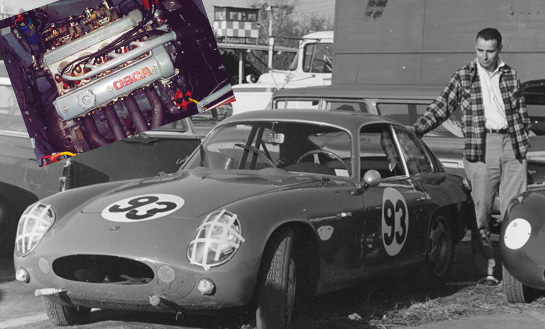
Jack Gordon with 0036 at Marlboro, late 1962. Inset, the twin plug head engine as it is today. Black and white photo by Bob Lorch.
The FIA could rule however they pleased, but the organizers of the big four events, Sebring, Nurburgring, Targa Florio and Le Mans got cold feet, wondering if the crowds would come to watch mere GT cars. They decided to allow what was first called “Experimental” (later “prototype” class) cars up to four liters. This more or less defeated the entire FIA GT concept: it meant the big Maserati 151s and other big sports cars could run in the event. This included the eventual Le Mans winner, the four liter Ferrari 330LM driven by the famous team of Phil Hill and Oliver Gendebien. 1
Another, slightly less famous team had decided to pack up their helmets and goggles and head for France. Formerly famous for their exploits with the OSCA 750s at both Le Mans and Sebring, John “Jack” Gordon and John Bentley planned to return to Le Mans with another, much different OSCA. The new GT class presumably played right into the hands of the Maserati brothers, who had previously fielded 2000, 1500, 1100 and 750 cc sports race cars, but now had the new 1600GT to bring glory to the OSCA factory.
John Bentley had been active in SCCA racing driving Siatas and Porsches in the early 1950s and hooked up with Ed Hugus to drive a Cooper Climax at Le Mans in 1956. The crew finished a remarkable 8th overall, and launched an interesting career for Hugus, who would be successful at Le Mans driving a series of Ferraris. After participating in a series of driver’s schools, John Gordon knew that his Austin-Healey was not reliable enough to race.
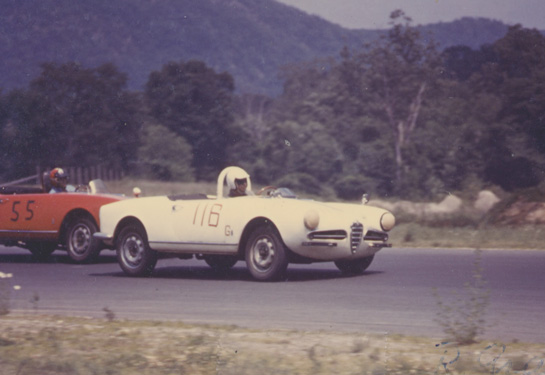
John Gordon in the Alfa 1300 at Lime Rock, June 13th, 1959. Behind him is R. Rubin, who would place 2nd in class G. Gordon placed 5th. Photo courtesy John Gordon.
A friend told him that Bentley had a used Alfa for sale that ought to be suitable. Gordon bought it and raced it throughout the next year. At the end of 1959, Bentley suggested they split the cost of a 750cc OSCA, and the team signed up for the 1960 12 Hours of Sebring where they won the Index of Performance. Their success in that event was recounted in VeloceToday (click here). Filled to the brim, they decided to go to Le Mans, with another OSCA 750 entered by N.A.R.T., garnering an 18th overall, completing 1982.080 miles at a speed of 82.5 mph. That adventure too, was covered by VeloceToday (click here).
As one might imagine, it is not easy to have an entry approved for Le Mans. The late Ed Hugus told this author how it was done, at least in his case. Hugus’s performance with the 1100cc Cooper Climax had impressed the ACO clerk-of-course Jacques Loste. “Look, Ed,” said Loste, “you’ve done very well here with the Cooper. You have an entry for the race anytime you want.” Hugus took him up on the offer and entered every event through 1965.
A similar offer must have also been extended to Bentley, who was also fluent in French and well known to the organizers. But the Bentley/Gordon team found its own fame. “The 1960 entry via N.A.R.T. was automatic for us after our Sebring Index win. Chinetti wanted us to have a chance at a 1-2 like de Tomaso had done a couple of years earlier,” said Gordon. Alas, the Le Mans Index of Thermal Efficiency in 1960 was won by the Lotus Elite driven by Frank Gardner and David Hobbs (yes, SPEED’s David Hobbs) who averaged 100 mph at 20 mpg.
Untold was yet another Bentley/Gordon success at Sebring in March, 1962, winning their class in their own 750cc OSCA. With their string of successes driving OSCAs, the OSCA factory beckoned and offered the team to be the official factory entry at Le Mans in June. Getting a factory ride at Le Mans might sound like an exciting dream-come-true adventure, but in reality, Bentley and Gordon again shared the purchase price of the OSCA, ex works at $6,833, a sum that would have bought a small house or large Lincoln Continental convertible. Then did they make any money on the deal? “Emphatically not!” said Gordon. Furthermore, as there was no insurance, had the car been wrecked it would have been a total loss. And what was in fact meant by “factory entry” was the appearance of one or two mechanics that looked after things as they broke down.
At the time, Gordon was working as an engineer for a manufacturer of rocket engines. He had no dependents, saved his money, and even got the company to schedule a business visit to Munich while in Europe. Bentley, married to a lovely lady named Fran, worked at the U.S. Navy Training Devices center at Port Washington L.I., where he was a producer of training movies. British born Bentley was also an author and journalist, who wrote for many car magazines. It was a team of contrasts that worked well. “I would say that Bentley was the schemer among the two of us. We collaborated four times in three different years, and I don’t know of many others who did that.”
The 1600 GT OSCAs at Le Mans
The 1962 Le Mans was not the competition debut of the OSCA Zagato 1600 GT: one had been entered at Sebring in March by the N.A.R.T. but retired with engine problems after 33 laps. But for a car which had been introduced at the Fall Turin Auto show in 1960, having its competition debut more than a year and a half later seems a bit strange. But there were many problems, including the requirement that in order to get homologated 100 cars would have to be constructed in a running twelve months. It was the first time OSCA had attempted what to them was mass production. The preferred coachbuilder was Zagato, who not only was far away from Bologna in the “terraced hinterlands” 2 of Milan but very busy building everyone else’s GT cars, many of which would compete in the same class as the OSCA. By the time they were homologated into the GT class, the original GT concept had been subverted and when Le Mans rolled around, it was decided to enter the cars in the Experimental Class, rather than the new GT class.
One of the ironies of motoring history is that we can tell you what the OSCA drivers had for lunch on that day of June 23, 1962, (ham, brie cheese, a bit of wine) but we can’t know for sure how many OSCA 1600GTS cars were built, how many had IRS, or even how many 1600GTs were built in all. We can state for certain that that there were two OSCA 1600 GTs entered that day, the Bentley/Gordon car, (s/n 0036) and another 1600GT2 (s/n 007), was probably entered by N.A.R.T. for the team of Jose Behra (not Jean) and American George Arents, painted white with a blue stripe. Several sources have listed this entry as an “Automobilia OSCA” entry, and it may have been a combination of both.
The 1600 GTS, s/n 0036
This one is the easier of the two to describe. It still exists in a collection, and is unique in several respects. We know that it was prepared by OSCA as a factory effort, specifically for Le Mans. It is the only Zagato bodied OSCA without ‘bubbles’ (that we know of) which were not deemed necessary for Le Mans. It is one of the few GTS versions, complete with the twin plug head and 45 DCO carburetors. Gordon describes 0036: “My GTS had 45 mm carbs, and a 9.6 compression ratio. There were 2 distributors, one 5-wire unit in the normal Fiat position, the other 5-wire Marelli unit mounted transversely off the tail of the intake cam. It was tight quarters in that engine bay.” 3 Already very familiar with OSCA engines, Gordon assessed the GT engine: “The factory data quotes a rating of 144 bhp with 42mm carbs @7000 rpm. The engine could be considered a derivative of the type 372DS of 1957 (1491 cc, single 8-wire distributor at the front of the timing case driven off the intermediate sprocket, 141 hp @ 6700. The original design of the OSCA block differs in a few details from the Fiat 1500 mass-production block.”
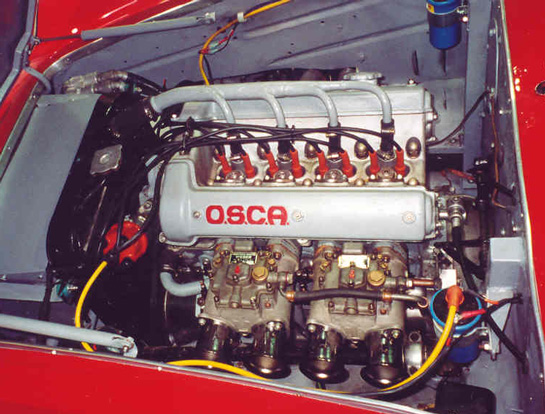
View of the rare the OSCA twin plug had and huge 45 DCO carbs.This particular engine has the extra distributor drive off the front timing cover vs the rear of the intake cam.
The car also had an 80 liter gas tank which made it tail heavy. Like most of the OSCA GTs, 0036 was equipped only with a four speed transmission. In one of the strangest twists of OSCA history, 0036 had a live rear axle. Heralded by the press for their full four wheel independent suspension, many of the OSCAs did not have IRS: 0036 was not equipped with IRS, perhaps because at Le Mans, it was so smooth that an IRS would have been unnecessary. But that is a guess.
Part II 007, Posteriors, and the Race
NOTES
1 Time and Two Seats, Janos L. Wimpffen, Motorsports Reseach Group, 1999
2 OSCA, La Rivincita dei Maserati, Orsini and Zagari, Nada, 1989
3 John Gordon’s comments and recollections from email interviews and questions, January to April 2011.
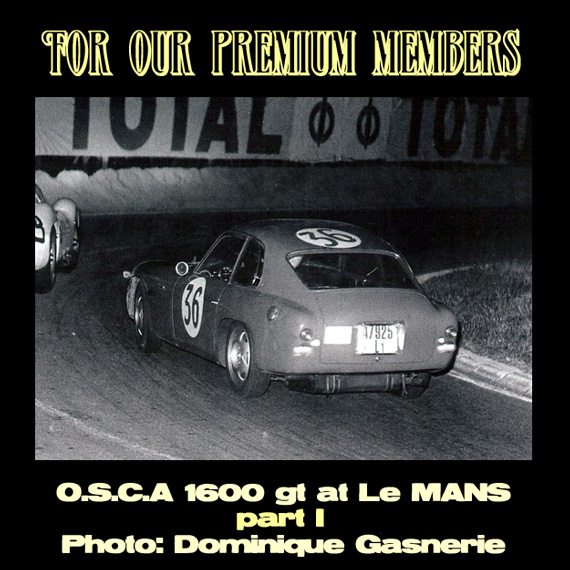
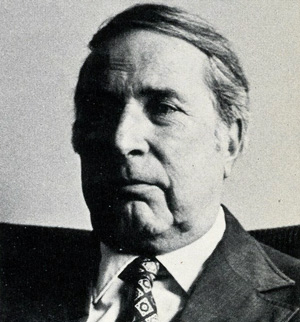
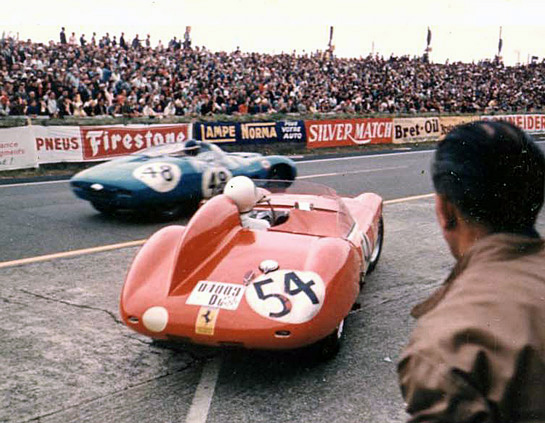
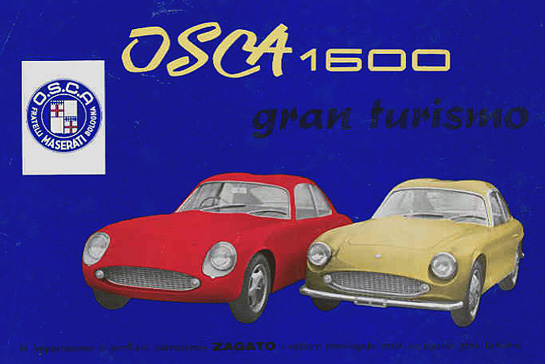
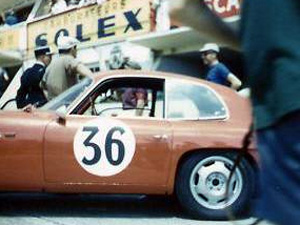
Very, very good !
Look! Roadgoing cars on skinny tires! We have to get back to this idea again!
cool amadori wheels!
hi toly!
these are the same skinny high-profile 155 x 15 michelin x sneakers that i used to wear on my giuliettas during 1958-1969.
hi jeff!
recent attempts to get replicas of these amadori wheels made have been fruitless so far.
Great to see a particular, one off OSCA 1600 GT.
The car was modified for the race whit a modified front and particular covered highlamps; some of these cars are in my book “Ruote da corsa” in original look
and with or without covered highlamps and only with Amadori – Campagnolo wheels.
hi Toly! Next month in my website You’ll find a complete register of Appia Zagato.